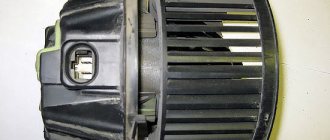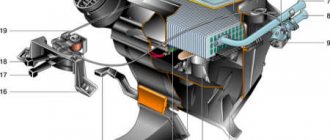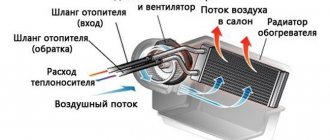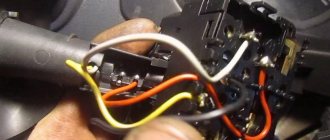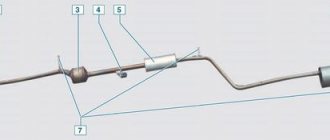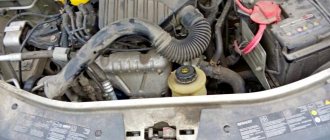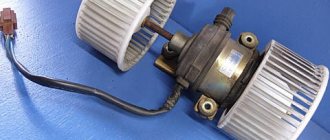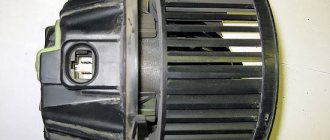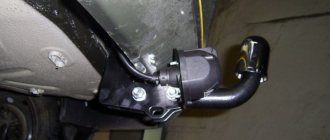Air distribution is shown in Fig. 8.1.
1 - Side deflectors; 2 — Air ducts for heating the footwell; 3 - Central deflectors; 4 — Air ducts for heating the windshield.
Air ducts are shown in Fig. 8.2.
1 - Front right transverse air duct; 2 - Front left transverse air duct; 3 - Front right air duct for heating the footwell; 4 - Front left air duct for heating the footwell.
The heater is shown in Fig. 8.3a-c.
5 - Distribution block; 6 - Heater radiator; 7 - Heater pipelines; 8 — Passenger compartment fan resistor; 9 — Front left air duct for heating the footwell; 10 — Air recirculation control cable; 11 — Air distribution control cable; 12 — Air temperature control cable.
13 — Passenger compartment fan; 14 - Front right air duct for heating the footwell.
15 - Evaporator; 16 — Expansion valve
The cold weather is coming, and in order not to freeze in the car, I decided to fix the heating system. Before repair (initial data): - the stove produces barely warm air at the first fan speed, and then if you press the gas pedal to 2-3 thousand revolutions - I know that during the previous antifreeze replacement (I changed it myself) there was a lot of dirt, as then I learned from the video that these were particles from the crumbled partition of the coolant expansion tank, which, logically, clogged the heater radiator
It was decided for replacement and cleaning: 1. drain all the antifreeze (by the vandal method, i.e. open the tank lid and disconnect the pipe that goes to the large radiator, without using a hole, but simply pouring the antifreeze onto the ground, you can use the instructions in the video)
2. blow out the system (for purging, I bought a foot pump for inflating air mattresses for 400 rubles) 3. replace the coolant expansion tank (bought for 500 rubles) 4. rinse the system with distilled water (bought 2 bottles of 5 liters, 60 rubles each) 5. drain the distilled water 6. blow out the system again (the most important thing now is to blow out the stove so that nothing flows into the interior when removing the stove) 7. remove the stove (video below)
I’ll just add on my own that I removed the radiator using a ratchet wrench with a 13mm head and a screwdriver with bits.
I didn’t have a torx20 attachment, everything unscrewed well and the torx15 screwed in, and in order to unscrew the tubes from the radiator, I removed the front panel with the buttons and unscrewed the block with the heater adjustment. The panel is attached only with latches, there is no need to unscrew anything, and the block is unscrewed using the same torx15 (although you may also need a torx20.
Read more: Who made the Mini Cooper
8. wash the stove with whatever you can, I washed it with several packets of citric acid with boiling water, then vinegar with boiling water, just under the pressure of either hot or cold water, then poured soda in, poured boiling water with lemon again... in general, it’s still a hemorrhage, if not It’s a pity 1400, you’d better buy a new radiator, because I never completely washed mine. out of 12 pipes, 4 seem to be clogged, but I hope that over time they will break through on their own... 9. put the stove in place 10. fill in antifreeze and expel air from the system (instructions in the video in point 1) I filled TOTAL as last time concentrate (diluted 1 to 1 with distilled water) I bought 3 liters at 400 rubles per liter (when diluted, it turns out to be 6 liters, i.e. there is still left in stock)
Result: - the stove heats up and you don’t need 2-3 thousand revolutions for this, just warm up the engine, clogged 4 pipes may somehow affect the heating, but in my opinion it’s already very hot in the car, if you turn the heater on full - new a white-transparent tank looks much more beautiful than the old yellow-dirty one without a partition
I didn’t take a picture of the old one, I just threw it in the trash.
— gained experience in replacing the tank and cleaning the radiator, became more familiar with the heating system — I know that the system contains pure antifreeze, but since... there was a full *0p@, then in the spring I plan to change it again
The operation of ventilation and heating systems is aimed at creating comfortable conditions inside the car interior. The serviceability of these systems allows you to create an optimal temperature and remove frost or moisture from the windows.
Causes of failure
So, we should move on to consider the features of why the stove does not work on a Renault Logan:
- Air filter clogged.
- The resistance has failed.
- Fuse F36 faulty.
- Plug contacts are faulty.
- Fan switch failure.
- Incorrect position of the air control damper, etc.
We will look at these reasons in more detail below.
Dirty and clean cabin filter
One of the most common causes of functional failure of the stove in practice is a clogged cabin air filter. Its location often leads to various foreign objects entering it from the outside, including tree leaves and insects. This leads to a sharp decrease in the flow of hot air directed into the cabin. Therefore, experienced drivers usually begin repairing the stove with a thorough inspection of the filter housing. It is located in the cabin under the bottom of the front panel, near the location of the passenger's left foot. If the filter is really clogged, clean it by throwing away all foreign objects and carefully cleaning the inside of the housing.
Quite often in practice there are incidental cases when the heating fan operates normally at all speeds (1st, 2nd and 3rd), except for the fourth. In such situations, the reason for the abnormal operation of the Renault Logan stove is, as a rule, the resistance: it has failed for various reasons and needs to be replaced with a new one.
Resistor (resistance) of the heater of this car
If the stove fan does not want to turn on at all, an almost unambiguous diagnosis is a malfunction of fuse F36. Most likely it is burnt out and needs to be replaced with a new one. However, when checking it, it also happens that the fuse is intact and functional, but the fan stubbornly does not turn on. Then the fan relay must be checked: it is replaced, after which the stove often begins to operate normally in normal mode.
But, unfortunately, a third option is also possible. So, the relay has been replaced, but the stove has not resumed normal operation. Here you cannot do without checking the contacts of the plug that supplies voltage to the fan motor. To test the motor itself, it must be directly connected to the battery using an open plug. If the electric motor is working properly, the reason may be in the fan operating format switch, but if it works, you cannot do without removing and checking the commutator brushes.
Electric motor with fan
It is necessary to highlight another widespread cause of malfunction of the Renault Logan car heater. Practice has shown that this cause in many cases is the air control damper, which blocks the flow of hot air into the cabin. Here you need to immediately check the functioning of the cable wire enclosed in a white protective sheath, since, according to statistics, in the vast majority of situations it is the culprit.
The article examined the main formats of Renault Logan stove malfunctions and algorithms for eliminating the causes of the breakdown on your own. Of course, it’s much easier to go to one of the reliable service stations so that experienced specialists can handle the repairs, but this option may not be cheap. However, if the driver self-critically understands that he cannot cope with a broken stove alone, willy-nilly he will have to seek help either from a professional partner or from the same service station. Good luck!
DIY stove motor repair
Typically, failure of the stove fan is caused by high wear on the motor brushes. In order to replace them, you just need to press out three latches, or use a Phillips screwdriver and unscrew 2 bolts.
The easiest way to bend the latches is with a flat-head screwdriver.
After access is opened, we check the condition of the brushes and replace them if there is high wear.
The location of the brushes is marked with a marker.
Dimensions for brushes: 4 by 4 mm, and length up to 2 centimeters. If you find any that are longer, you can sharpen them. After repairs, it is necessary to lubricate all rubbing elements with high-temperature oil.
If the malfunction is related to a technical part, the housing has collapsed or individual parts have burned out, then the entire element must be replaced with a new one.
Installation of a repaired or new part should be carried out in the same way as removal.
The device of the Renault Logan car heater
The heater is located under the dashboard in the central part. The main components of the heater are a fan, distribution dampers and a radiator.
Main components of the Renault Logan heater: 5 - distribution block; 6 — heater radiator; 7 — heater pipelines; 8 — fan resistor; 9 — front left air duct for heating the footwell; 10 — air recirculation control cable; 11 — air distribution control cable; 12 — air temperature control cable
Heater radiator
The central unit of the heating system is the heat exchanger of the heater (stove), or radiator. The main function of the radiator is to heat the air entering the cabin.
The heater radiator is responsible for heating the air entering the cabin
Heater fan
Air is actively supplied to the heater while driving through special holes in the front panel lining. When more intense air supply is needed, the fan comes into play. The faster it rotates, the more air flows to the heating systems.
The fan provides more air to the heater
Heater fan resistor
In physics, a resistor is understood as a passive element of an electrical circuit that can perform different functions: convert current into voltage and vice versa, limit current, absorb electrical energy, etc.
As part of the stove, the resistor is responsible for the operation of the fan, namely: it regulates the rotation speed of its blades. A resistor is connected to the motor and distributes the current, typically providing four fan speeds.
The resistor allows you to adjust the speed of the heater fan
Why does a resistor fail?
The cause of resistor failure is burnout. The fact is that it is constantly energized and transmits current. Experienced craftsmen, however, claim that the failure of the resistor may be associated with malfunctions or contamination of the fan as a whole.
When the resistor fails, all the electric current goes directly to the fan, and it only operates at the fourth, maximum speed. Therefore, diagnosing this breakdown will not be difficult for a car enthusiast.
How does the Renault Logan stove work?
Air enters the car interior - both naturally and with the help of a fan. Air coming from outside can pass through the radiator, thereby heating up, or past it. This depends on the position of the damper, which is connected to the temperature controller.
The radiator heats the air entering the cabin. This occurs due to the circulation, oddly enough, of coolant. It removes heat from the running engine, heats up and, in a heated state, flows through special pipes to the radiator. The maximum heating temperature can be up to 100 degrees - the system is closed and under pressure, which allows it to withstand such loads.
Heated air enters the cabin through deflectors - special openings located in the center and sides of the instrument panel. The air supply intensity is regulated using the heater control unit.
Replacing the stove fan yourself
The Logan heater fan is integrated into one unit with the motor, so it is dismantled along with it. Many Renault Logan car owners say that to dismantle it, you need to completely remove the central panel of the car, but there is a way to do this by simply unscrewing two mounting bolts.
To remove the stove fan, first remove the facing of the right pillar, you need to carefully pry it off with a screwdriver and pry off the two latches. It opens the top screw, which is unscrewed with a T20 screwdriver. At the bottom of the panel there is a plastic plug, under which there is another self-tapping screw with the same head. After unscrewing the screws, the plug is closed and the door seal is completely removed so as not to damage them during operation. Afterwards you can remove the fan.
The panel is carefully removed from the guide elements. The Renault Logan heater fan is located under the glove compartment, installed in the air duct. You can see it even if you cannot bend the panel as far as possible; all manipulations are carried out by touch.
First, carefully disconnect the electrical connector, then remove the Renault Logan heater fan. To do this, press the latch and turn it clockwise until it clicks and pull it out of the mount. This pulls back quite a bit on the right side of the dashboard, so you have to be careful not to break the plastic.
The two types of fans differ in connectors and mounting to the case. Replacing the stove fan with a Logan is carried out after dismantling the entire assembly. You remove the cover and see the motor, if it works, just lubricate it with ATF from a syringe. If this does not help, you can ring it, check the brushes, but most likely the heater motor will need to be replaced. After inspection, maintenance or replacement of the unit, it is installed in place in the reverse order.
You can remove and change the heater motor on a Renault Logan yourself. This does not require any special tools or equipment. The only difficulty is that dismantling and reinstallation will need to be done by touch. But with some skill, this does not pose a problem. In order for the new part to guarantee reliability, it is better to buy a heater motor from the original manufacturers, which Renault recommends, there are only two of them. After installation, you need to check the reliability of the panel, the lining of the right pillar and the rubber seal. If this is not done, extraneous creaks and drafts will make the ride uncomfortable.
Causes of malfunctions in the heating system
When it becomes cold in the car, although the heater is in active mode, there is no need to panic. This is a completely ordinary situation that happens everywhere and to everyone. You need to accept the fact that the heating has turned off.
The only correct solution in such a situation is to find the cause. There are several options why the stove suddenly began to work poorly or not heat the interior at all. But Logan's advantage is its simplicity. The car is not equipped with complex and multiple electronics, where even an experienced auto mechanic can get confused. The design is quite standard and budget-friendly, which does not prevent Renault from being a reliable and durable car. The stove is one of the few weak points of the model. But even when it doesn’t heat well, there are a number of solutions for the current situation.
Drawing hasty conclusions and making the most dire diagnoses is not recommended. Yes, there are some malfunctions that will be quite problematic and relatively financially expensive to fix.
But basically, fixing breakdowns requires spending a minimum of money and free time. Again, the design of the Renault Logan car, which is not overloaded with unnecessary and complex elements, shows its advantages.
Well, let's go over the main factors that can cause poor performance of the cabin heater.
- An air lock has formed in the system, due to which the radiator does not heat up;
- Problems with the thermostat, and therefore the engine does not heat the coolant;
- The heater radiator is clogged with debris;
- There are problems with the engine itself;
- Poor air flow;
- The fan motor is broken;
- The fan speed controller has malfunctioned;
- The heater valve has failed.
Here are the main reasons why the stove on your Logan may not heat well or not work at all.
What do we do next? Absolutely right. You need to understand how each of these problems is solved.
Possible causes of Renault Logan stove failure
Logan stove assembly
Unfortunately, Renault Logan owners often have problems related to the fact that the heater in their car does not heat up. Most complaints are due to the fact that the stove either does not heat at all, or that cold air is blowing from it. With such questions, motorists turn to forums and car repair shops, although the causes of breakdowns are simple and fixable. After reading the necessary information, you can deal with the problem yourself. Possible causes of the problem are described below:
Heater housing
Ventilation, heating and air conditioning system: Design description
Diagram of the ventilation, heating and air conditioning system
: 1 - compressor; 2 — fan of the engine cooling system; 3 - low pressure pipeline; 4 - valve for filling and releasing refrigerant from the low pressure pipeline; 5 - gearbox; 6 — heater fan; 7 — heater housing; 8 — temperature regulator damper; 9 — heater radiator; 10 - evaporator; 11 — front panel; 12 — valve for filling and releasing refrigerant from the high-pressure pipeline; 13 - high pressure pipeline; 14 - receiver; 15 — refrigerant pressure sensor; 16 — radiator of the engine cooling system; 17 - capacitor
The vehicle can be equipped with either a ventilation and heating system or a ventilation, heating and air conditioning system, which serves to create the most comfortable conditions for the driver and passengers, regardless of weather conditions. The ventilation and heating system includes: heater, heater fan, air ducts and deflectors. Air ducts carry air from the heater to the windshield and side window vents, to the central and side vents on the instrument panel, as well as to the vents in the heater housing to supply air to the feet of the driver and passengers.
Ventilation, heating and air conditioning control unit
The system is controlled by turning the handles located on the ventilation, heating and air conditioning control unit. The control unit is installed on the instrument panel console. The heater is installed under the instrument panel in the center, the air ducts are secured under the cross member of the instrument panel. The heater housing contains a heater fan, distribution dampers that direct air flow to specific areas, and a heater core connected by hoses to the engine cooling system.
Coolant constantly circulates through the heater radiator. Depending on the position of the damper associated with the temperature controller, outside air may pass through or bypass the heater core.
When the car is moving, air enters the heater through the holes located in the left and right decorative trims of the front panel. To increase the air supply to the cabin while the car is moving, as well as when parked, the heater fan is used. The intensity of air supply is determined by the fan rotation speed. The fan motor, depending on the connection of an additional resistor, can rotate at four different speeds. The air flow in the cabin is controlled by an air flow distribution regulator, which is connected to the dampers by rods. By controlling the flaps, the regulator directs air flows through the air ducts to the central and side deflectors, to the lower ventilation holes in the heater casing, as well as to the glass blower grilles located in the instrument panel.
Cabin air outlet valves (with rear bumper removed)
Air exits from the passenger compartment through openings located on top of the sides of the trunk and further out through valves installed behind the sides of the rear bumper.
To speed up the heating of the cabin and prevent the entry of outside air into the cabin (when the car is driving along smoky, dusty sections of the road), an air recirculation system is used. When you move the lever for turning on the air recirculation mode, the recirculation system flap blocks the access of outside air to the car interior, and the air in the car interior begins to circulate in a closed circuit without exchange with outside air. Some cars are equipped with an air conditioning system. The air conditioning system is designed to reduce the temperature and humidity in the cabin. The air conditioner is turned on by pressing the air conditioner switch button located in the ventilation, heating and air conditioning control unit, while the heater fan must be turned on. When the air conditioner is turned on, the indicator light located next to the air conditioner switch button lights up.
Possible causes of Renault Logan stove failure
Owners of Renault Logan cars often encounter the following problems: the heater does not heat up or cold air comes out of the deflators, although the pipes (the same ones through which the coolant, heated by the engine, goes to the heater radiator) are hot. There may be several explanations for this phenomenon:
- an air plug has accumulated in the pipe;
- Cabin filters or radiator cap are clogged;
- fuses have become unusable;
- low-quality/used antifreeze or insufficient coolant level;
- the antifreeze expansion tank has become unusable (usually after 100 thousand km), or its cap is loosely secured.
Do-it-yourself dismantling and replacement of the Renault Logan stove
The stove is an integral part of the heating system of any car. Thanks to this device, comfort is ensured inside the vehicle during the cold season. As coolant circulates through the heater radiator, the air passing through it heats up. Through the fan and air ducts, heat is supplied and distributed throughout the cabin. Only with a fully functioning system will it be warm inside the car, regardless of the weather outside.
Choosing a stove and fan
On Renault Logan you can install both the original heater radiator and its analogues. Let's consider all the options:
The catalog number of the original Renault Logan heater radiator is 6001547484. The part is quite reliable and rarely fails. According to the technical documentation, the service life is 5-6 years, depending on the frequency of use and the region of operation. The average price in the Russian Federation is 4,500 rubles.
Let's look at the main analogues of the original part that are suitable for Renault Logan:
| Manufacturer's name | Catalog number | Average price in the Russian Federation in rubles. |
| Dello | 30600105470484 | 1200 |
| Asam | 30910 | 1450 |
| Luzar | LRH 0998 | 1625 |
| Breckner | BK52002 | 1680 |
| Topran | 700 963 | 1875 |
| Vemo | V46-61-0005 | 2400 |
| Stellox | 10-35108-SX | 2550 |
| Automotor France | ARD8595 | 2800 |
| Valeo | 812 374 | 4600 |
Presented in the table, the analogs declared themselves to be reliable and recommended for installation on a Renault Logan car.
Now let's select the Renault Logan heater fan:
6001547691 - original catalog number of the heater fan. The part is reliable. The average service life is 5-7 years, with proper care of the unit. The average cost is 15,000 rubles.
Possible analogues:
| Manufacturer's name | Catalog number | Average price in the Russian Federation in rubles. |
| Dello | 30600105470691 | 3300 |
| Luzar | LFH 0991 | 3900 |
| Valeo | 715 057 | 7500 |
| Breckner | BK60003 | 8000 |
| Behr-Hella | 8EW 351 149-541 | 15 000 |
As can be seen from the table, most analogues are produced by well-known companies that produce spare parts, and at the same time, they are cheaper than the original part.
How to remove the heater on a Renault Logan video
Replacing the heater radiator for Renault Logan
Nowadays it is no longer possible to imagine a car without a heater. At least in our harsh climate. If the stove in a car fails in thirty-degree frost, then such a car will go very close. This applies to all cars, and Renault Logan is no exception. The heater radiator in this car can become a source of real headache for the car enthusiast. But fortunately, it can be replaced, and you can do it yourself. And we will dwell on this point in more detail.
Trouble-shooting
I think you understand perfectly well that it will not be possible to consider the features of solving each of the considered malfunctions in the format of one article. But if you are interested, write in the comments. Then we will prepare separate materials for you, where we will consider all the pressing issues regarding repairs.
Before we begin, I want to give you one simple piece of advice. Act sequentially, starting from the least simple and moving towards the most complex. After all, in reality, it is much easier to replace a blown fuse than to disassemble half of the console or rummage through the engine compartment in search of the source of problems with the stove. If you start with simple measures, when you do not know exactly the cause of the malfunction, you will be able to avoid unnecessary and complex processes. Everything here is extremely logical and understandable.
And once everything is clear, then we can begin to examine the malfunctions.
I will try to reveal to you the essence of the reasons considered, explain who is to blame and what needs to be done. Whether you repair the Logan yourself or contact a car service is up to each individual. But you can save a lot of money by doing the repairs yourself.
If everyone is ready, we begin. I will divide the faults into two groups.
First group
This will include 4 malfunctions, for the solution of which it is not necessary to involve specialists. If you study the instruction manual and understand Logan's design, everything will be done quickly and efficiently.
see also
- Airlock. Perhaps the reason for its appearance is errors during the previous antifreeze replacement. Logan's design provides that the air must come out on its own. But sometimes it doesn't work. To solve the problem, you should disconnect the two pipes from the interior heat exchange, and then, alternately connecting them back, coolant is poured into the tank. When fluid begins to flow from the second tube, insert the hose into place. Such simple manipulations can significantly increase heating efficiency;
- Thermostat. With such a malfunction, the engine may not reach the required temperature, and therefore the coolant will not heat up and transfer heat to the heater radiator. Solving the problem is simple. The thermostat needs to be replaced. You will find it near the crankcase at the bottom of the cylinder head;
- Problems with the pump. It may partially or completely fail. As a result, due to the lack of pressure, coolant does not enter the radiator and does not warm up the air flowing into the cabin. The pump must be changed without fail;
- The radiator is dirty. This usually happens when ordinary water is used instead of antifreeze, or low-grade coolant is poured. You can try to clean the radiator. But don't expect any special effect. It's much easier to replace it. To do this, the heater housing in the cabin is disassembled. Before this, all the coolant is drained.
We dealt with the first group. But we have 5 more possible reasons ahead why the stove on Logan refused to heat properly, and the people inside became cold.
Second group
There are a number of videos online where experienced craftsmen and ordinary car enthusiasts demonstrate in practice the nuances of repairing a Logan stove. There is nothing complicated here. But if you don’t have the slightest experience, it’s not always worth taking on a job.
see also
The second group included 5 more faults. Let's look at them.
- Engine problems. Poor heater performance may be due to air pockets in the cooling system. When the engine overheats, the head gasket is damaged. Air begins to enter the water cooling system. To check, open the cap on the coolant reservoir with the engine running. If you see air bubbles, there is clearly a problem with the head gasket;
- Insufficient air flow. Here the source of trouble must be looked for in the cabin filter. The simplest solution would be replacement;
- Stove motor. Also a frequent guest on programs about poor performance of furnace equipment in Logan. If no air comes out when you turn on the heating, the motor is probably broken. It will not be possible to repair it. Replacement only;
- Fan regulator. It is connected to the motor via an electrical circuit. Check the wiring, as well as the condition of the regulator itself. If anything, for replacement;
- Radiator tap. It also happens that a faucet breaks down. That is, the valve that allows coolant to flow to the Logan heater radiator has broken. We are making a replacement.
It is extremely unlikely that all these breakdowns will happen at the same time. Often one thing goes wrong. And almost every element that requires replacement is cheap. At least in relation to Renault Logan.
You can clearly see that you can solve the problem with the stove yourself. Whether to do this or not, decide for yourself.
Thanks everyone for your attention! Subscribe, leave comments and invite your friends to join us!
Troubleshooting Renault Logan heater problems
Logan heater diagram
To eliminate problems, you need to find out why each of the reasons occurs.
- The system is not perfect, air pockets may appear. This usually happens during car repairs or when replacing the coolant. You can remove the blockage yourself. To do this, you need to disconnect the two pipes from the system and start pouring antifreeze into the expansion tank. At the same time, connect the pipes one by one. Antifreeze should flow through the second tube and it should be immediately reinserted into the system. The oven works much more efficiently.
Inlet and outlet pipes of the heating system - If there are no obvious reasons for the stove failure, you need to check the condition of fuse F36 in the passenger compartment. If it is burnt out, it must be replaced with an appropriate one.
- When using low-quality antifreeze, there is a risk of corrosion of the engine elements with which it comes into contact. Metal machines rust, the entire system becomes unusable. You need to choose antifreeze carefully, and it is important to remember the consequences of using low-quality liquids. This will affect not only the functioning of the stove, but also the entire car.
- Few people attach the required importance to the tightness of the closed expansion tank cap. The consequences can be very different: from the release of coolant to the rupture of a radiator pipe or can. The lid must be tightly closed and the valve must work. If the tank itself malfunctions, it is replaced with a suitable one. How to check the expansion tank cap is discussed here.
- To clean a clogged cabin filter, you need to disassemble it. In the cabin, it is located under the panel next to the front passenger's left foot. If the stove does not work at all, then you need to check fuse F36. If it works, then the problem is in the relay on the control panel.
- The thermostat in the car may not function. The coolant does not heat up the heater. This problem can be solved in one way - by replacing the thermostat. It is located near the gearbox. Before replacing, you need to drain the old antifreeze.
- The radiator becomes clogged if the car owner fills it with water instead of coolant. This causes corrosion of the entire system, as well as the appearance of scale on the walls of the water jacket. As a result, the pump is not able to create the required pressure and the antifreeze simply does not reach the heater radiator. Cleaning will not help much in this case; the radiator will have to be replaced with a new one.
- There is little air flow, the problem is in the cabin filter. Poor quality or old filters are replaced at low cost.
- If the pump is not working properly, there is not enough pressure. Antifreeze does not enter the stove, the interior does not warm up. The motor may overheat. In this case, the water pump must be replaced. Before replacing, you need to drain the fluid from the system.
Interesting on the topic: Check Engine on Ford Focus 2: don’t panic
Preventing stove breakdowns
Of course, it is much easier to prevent problems from occurring than to fix them. For the stove to work without failures, you must:
- change the cabin filter regularly;
- use only high-quality antifreeze (official dealers recommend GLACEOL RX Type D 1 Renault 7711428132 from ELF) to avoid damage to the radiator and pipes;
- It is advisable to flush the entire system with water or a special liquid before the start of the season.
Using the seemingly simple methods described above, you can repair the Renault Logan stove yourself. However, it is worth taking on this business if you are completely confident in your abilities and skills. Otherwise, you may not only fail to repair the stove, but also render the entire heating and ventilation system of the car unusable.
- Author: Irina Silyanova
Rate this article: (16 votes, average: 3.6 out of 5)
Troubleshooting
To troubleshoot a Renault heater , we will try to reveal the essence of each of them.
- An air lock in the Renault heating system can be caused by earlier work to replace antifreeze. As a rule, the cooling system of a Renault Logan car is designed in such a way as to automatically get rid of air pockets. The video guide shows how to change the timing belt and drive belts on a Volga Cyber with your own hands. Despite the perfection of this design, air pockets still appear, as a rule, during the process of repairing the cooling system. There is one simple way to eliminate an air lock on a Renault Logan. Removing the front bumper on a Renault, how to reliably solder the bumper part 1 u.p. No. 196. Disconnect both pipes from the cabin heat exchange, then, connecting each pipe in turn, pour coolant into the expansion tank. After such manipulations, the antifreeze should flow through the opposite tube, at which point you need to insert the second hose into place. How to remove and install sills on a Renault Duster: photo. Usually after such actions the stove heats noticeably better.
- If the thermostat does not work on a Renault Logan, the engine does not reach the required operating temperature, as a result of which the coolant is not able to warm up the heater radiator. To solve this problem, it is enough to change the thermostat, fortunately this is not difficult to do. The thermostat housing is located at the bottom of the cylinder head near the gearbox housing.
What to do if the Renault Megan 2 stove does not heat well
It is necessary to pause after you bring the fluid level in order, since during a fluid leak, air pockets often form and you need to wait for them to come out.
The engine head gasket is blown. The engine is made up of a block and a cylinder head connected by a special gasket.
If the integrity of this gasket is compromised, then the fluid will ignore its usual path and flow into the cylinders or muffler, in the latter case puffs of white smoke will appear. This scenario is possible with poor-quality broaching. Due to the fact that most of the liquid will go to nowhere, the Renault Megane heater does not heat well, the system will have a significant shortage, and the heater will stop functioning according to regulations.
The solution to this problem is to quickly replace the gasket. This situation is scary because you can, without knowing it, destroy the Renault Megane stove that does not heat well, which will lead to much more significant costs.
If the heater does not blow in the Renault Megan 2, then the fan may have stopped working. Perhaps the simplest and most understandable reason.
Here, of course, you will have to think about which components of this process have ceased to be participants. The replacement options are as follows: The Renault Megan 2 stove does not heat well for the following reasons. The stove radiator is clogged.
Fan fault
In Renault Logan and structurally similar cars, repairing the heater fan must begin with checking the fuse. Before installing a new part, you must make sure that the fan speed switch is working correctly, otherwise you will need to replace it again. You can find the fuse in the interior mounting block. It is marked in green, and on the Renault electrical diagram it is designated as F36.
If the stove does not heat or does not work well, making a crunching or squeaking sound, then you will have to carry out repairs. In advanced cases, it may come down to a complete replacement of the node.
There is no need to remove the entire Renault Logan dashboard: just unscrew two bolts. The first is located under the facing panel of the right drain, the second is under the plug in the lower right part of the glove compartment. After unscrewing both screws, you need to remove the glove compartment from the guides by pulling it towards you. Be careful not to break anything. The unit will be directly under the glove compartment, it is impossible to see it in this position. Having found the fan, you need to find the latch and turn the entire assembly clockwise.
Renault Logan heating system device
The main component of an automobile heating system is the heater heat exchanger, a more common name is the heater radiator. Its purpose is to heat the air entering the car interior to the temperature set by the driver or his passenger. The radiator heats up due to the circulation of antifreeze. The coolant heats up during the process of removing heat from the operating power unit. The closed nature of the cooling system allows pressure to be created in it. Therefore, the temperature inside can be above 100 degrees.
Another component of the heating system is an electrically driven fan. The fan provides air from the street and regulates this process.
The system has a damper for regulating the temperature of the air entering the car interior from the heater. Depending on the angle of rotation of the damper, the amount of air passing through the heat exchanger of the heater and the amount of outside air entering without entering the heat exchanger are regulated.
You can also indicate the presence in the system of dampers for distributing the air flow entering the car interior through air ducts from the heater. Simply put, the air that blows onto the windshield and side windows.
How does the heating system work?
The principle by which the heating system for Renault Logan is designed has long been used by the automaker. The heater radiator is connected to the engine cooling system. Hot antifreeze circulates in it. The entry of heated air into the cabin through the air ducts is controlled by a damper controlled by a cable drive.
The fan can operate in four modes. Voltage is supplied to the fan contacts using a relay. The rotation speed is adjusted using a resistor, which is located in the device switching circuit. You can find this part behind the front panel trim, where the driver’s right foot is located. The resistor is white, and if you look under the panel you can easily find it.
To find the location of the relay, just open the hood of the Renault Logan. A mounting block is installed near the negative terminal of the battery. Here is the part you are looking for. To protect the electrical circuit for switching on the ventilation system, a 30 ampere fuse is installed. It is located in the mounting block, but located in the car interior. The fuse is marked, according to the electrical circuit diagram, with the index F36. You can find it by the diagram that is attached to the operating instructions or by color (green).
A little about the air conditioning system of the Renault Logan car
The Logan air conditioning system consists of a compressor driven by a belt from the engine crankshaft pulley. The compressor pulley has an electromagnetic friction-type clutch, which will disconnect the compressor shaft from the pulley or connect them when the air conditioner is operating according to a certain signal from the electronic engine control unit.
During operation, the compressor compresses the refrigerant vapors that will come from the evaporator heat exchanger to a sufficiently high pressure level. This achieves a significant reduction in temperature.
A pressure reducing valve is built into the compressor and can perform a protection function that is triggered when the pressure increases to a value that exceeds the permissible value at the outlet of the compressor itself. The reasons for the operation of the pressure reducing valve may include failure of the valve that is responsible for high pressure, as well as the failure of the electric fan. Other malfunctions are also possible.
